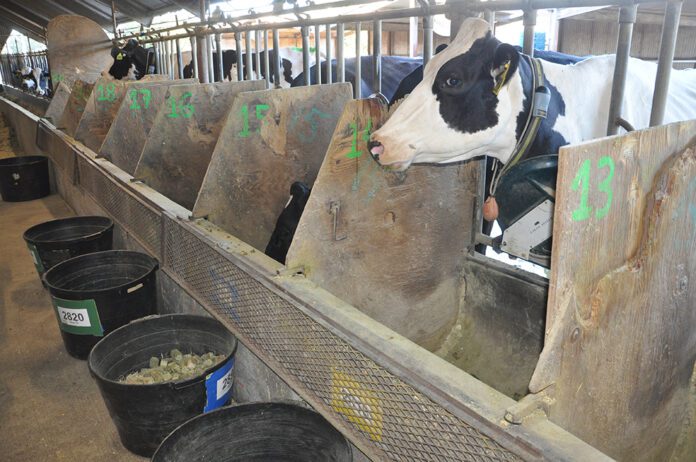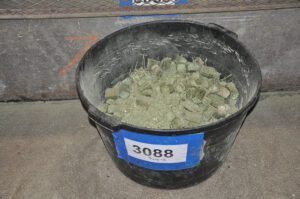
New feeding strategies for poultry diets may include using more fiber-rich almond hulls, helping boost demand for this almond byproduct.
A panel at the December Almond Conference also presented new research done with fermented hulls showing this dairy cow feeding strategy has the potential to reduce methane emissions from dairies.
Almond hulls have long been solely used as a supplement feed for dairy cows, providing fiber and energy in their total mixed ration. A look at feeding laying hens presents another market. Hulls are rich in carbohydrates, mainly non-starch polysaccharides, including cellulose, hemicellulose and pectin as well as soluble sugars. Analysis shows a range of fiber content from 15% to 16%.
A long-term ABC-funded study with laying hens found a diet consisting of 10% almond hulls had positive effects on production and egg quality. Pratima Adhikari of Mississippi State University conducted the feeding study, noting the hulls were shipped whole and then coarsely ground to a consistency between soybean meal and ground corn. There were seven rations fed over the length of the study, including standard corn and soybean meal, 5% almond hulls, 10% almond hulls and 15% almond hulls. Two other rations included almond hulls with enzyme inclusion at 136 grams per ton.
Throughout the peak lay age of 22 to 41 weeks, the study showed feeding a diet with 10% to 15% almond hulls can increase production, egg weigh and albumen height, an indicator of quality. Throughout the post-peaking age of 42 to 70 weeks, the use of 5% hulls in combination with the enzyme had a positive effect on egg production. Adhikari noted hens fed the diet with 15% almond hulls ate less feed compared to the other groups. The 10% hull with enzyme diet improved only egg weight. The 5% hull diet was the cheapest when calculated at different prices of hulls.
Conclusions of the study recommended to feed up to 15% hulls without any negative effects on the production in peaking age layers. Feeding hulls up to 5% can be done without any negative effect on the production in late-laying age layers. Adhikari noted as hull percentage in the diet increased, the yolk color score was lowered, suggesting corn was replaced by more hulls. When the energy was balanced with fat, unsaleable eggs were reduced in all hull-fed hens. It is not recommended, she noted, to feed hens without meeting their energy requirements and to not depend solely on hulls for energy.
In the next phase of the study, Adhikari said she would seek ways to increase the digestibility of amino acids and energy of the hulls and use better-quality hulls to see if there are changes with similar diet levels.
Hulls Added to Cubes in Cattle Feed
Focusing on almond hulls for the export market, UC Davis researcher Katie Swanson reported using different combinations of alfalfa and almond hulls in cube form would utilize the strengths of each product, with the potential of producing a synergy in combination and development of new products that could open new markets for almond hulls.
“They are exporting hay, why not add hulls to cubes?” Swanson asked.
This study was meant to evaluate the apparent digestibility, palatability and effect on production in dairy cows of alfalfa-almond hull cube mixes compared with plain alfalfa cubes and to develop new products with alfalfa and almond hulls. Swanson said previous work with cattle showed mixing low amounts of almond hulls with low to medium quality alfalfa hay could increase the overall dry matter and crude protein digestibility with only slight decreases in fiber digestibility.
For the study, the medium-quality alfalfa was cubed with 0%, 20% or 30% hulls. The cows in the study were fed a total mixed ration with the cubes added. Swanson reported the cows in the study consumed the crudest protein, neutral detergent fiber and acid detergent fiber, the least digestible, while on the 20% cube diet, but had the lowest digestibility for those components, spent the most time ruminating and had the highest milk fat percentage. The research suggests, Swanson said, that mixing low amounts of hulls could be beneficial for milk fat and yields compared with cows consuming no almond hulls.
Fermented almond hulls are also studied to determine if this form of hulls can be effective in reducing enteric methane emissions from cattle. It is well known lactating dairy cows can be fed a total mixed ration of up to 20% almond hulls.

Hulls are not difficult to ferment because they are high in sugars, said panelist Hamad El Mashad, associate professor of Animal Nutrition at UC Davis.
Fermented feed studies have been aimed at poultry and swine production where it has been noted for improved performance and nutrient digestion. It also has proved to decrease mortality rates and improve immune responses in poultry. There a few studies on cattle-fed fermented feed, El Mashad said, but probiotic supplementation with yeast trials show nutritional benefits in addition to potential reduction in enteric methane emissions.
The aim of the research is to develop methods for producing high-quality fermented feed from almond hulls and to determine the anti-methanogenic and nutrition value of fermented almond hulls. Noting differences among almond varieties, hull sugar content and phenolic compounds, El Mashad said hulls fermented with Saccharomyces Cerevisiae for 14 days reduced enteric methane production by 96% over 72 hours digestion at a 20% inclusion rate in the cow diet. Dry and green hulls produced fermented feed with similar characteristics.
Next steps in the research include scaling up fermentation process and producing a consistent and high-quality feed mix. El Mashad said feeding trials with dairy and beef cattle would determine the percentage of the fermented feed in the cattle ration. Currently, researchers have a CDFA Specialty Crop grant to create fermented feed from almond hulls and tomato pomace. Funding is pending for a CDFA Enteric Methane Reduction Grant.

Cecilia Parsons | Associate Editor
Cecilia Parsons has lived in the Central Valley community of Ducor since 1976, covering agriculture for numerous agricultural publications over the years. She has found and nurtured many wonderful and helpful contacts in the ag community, including the UCCE advisors, allowing for news coverage that focuses on the basics of food production.
She is always on the search for new ag topics that can help growers and processors in the San Joaquin Valley improve their bottom line.
In her free time, Cecilia rides her horse, Holly in ranch versatility shows and raises registered Shetland sheep which she exhibits at county and state fairs during the summer.















